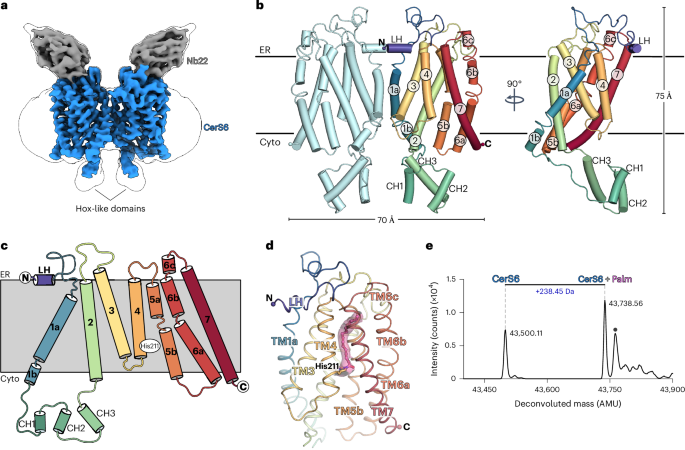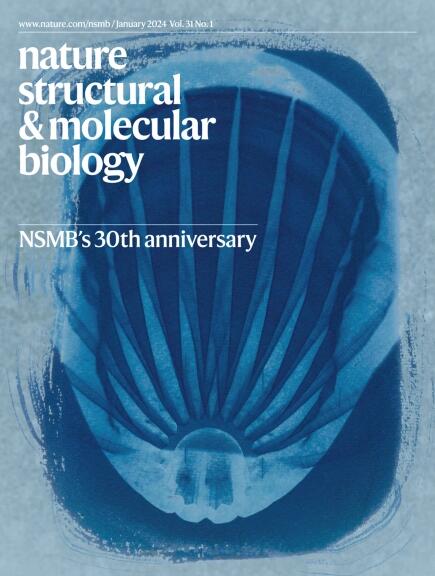Structural basis of the mechanism and inhibition of a human ceramide synthase
IF 10.1
1区 生物学
Q1 BIOCHEMISTRY & MOLECULAR BIOLOGY
引用次数: 0
Abstract
Ceramides are bioactive sphingolipids crucial for regulating cellular metabolism. Ceramides and dihydroceramides are synthesized by six ceramide synthase (CerS) enzymes, each with specificity for different acyl-CoA substrates. Ceramide with a 16-carbon acyl chain (C16 ceramide) has been implicated in obesity, insulin resistance and liver disease and the C16 ceramide-synthesizing CerS6 is regarded as an attractive drug target for obesity-associated disease. Despite their importance, the molecular mechanism underlying ceramide synthesis by CerS enzymes remains poorly understood. Here we report cryo-electron microscopy structures of human CerS6, capturing covalent intermediate and product-bound states. These structures, along with biochemical characterization, reveal that CerS catalysis proceeds through a ping-pong reaction mechanism involving a covalent acyl–enzyme intermediate. Notably, the product-bound structure was obtained upon reaction with the mycotoxin fumonisin B1, yielding insights into its inhibition of CerS. These results provide a framework for understanding CerS function, selectivity and inhibition and open routes for future drug discovery. Pascoa et al. reveal structures of the human ceramide synthase 6 and elucidate the enzyme’s mechanism. Furthermore, the work uncovers the basis of inhibition by the mycotoxin fumonisin B1.


人类神经酰胺合成酶的机制和抑制作用的结构基础
神经酰胺是一种生物活性鞘脂,对调节细胞代谢至关重要。神经酰胺和二氢神经酰胺由六种神经酰胺合成酶(CerS)合成,每种酶对不同的酰基-CoA 底物具有特异性。具有 16 个碳酰基链的神经酰胺(C16 神经酰胺)与肥胖、胰岛素抵抗和肝病有关,而合成 C16 神经酰胺的 CerS6 被认为是治疗肥胖相关疾病的一个有吸引力的药物靶点。尽管它们非常重要,但人们对 CerS 酶合成神经酰胺的分子机制仍然知之甚少。在此,我们报告了人类 CerS6 的冷冻电镜结构,其中捕捉到了共价中间体和产物结合态。这些结构以及生物化学特征显示,CerS 的催化作用是通过涉及共价酰基酶中间体的乒乓反应机制进行的。值得注意的是,在与霉菌毒素伏马菌素 B1 反应时获得了产物结合结构,从而深入了解了伏马菌素 B1 对 CerS 的抑制作用。这些结果为了解 CerS 的功能、选择性和抑制作用提供了一个框架,并为未来的药物发现开辟了道路。
本文章由计算机程序翻译,如有差异,请以英文原文为准。
求助全文
约1分钟内获得全文
求助全文
来源期刊

Nature Structural & Molecular Biology
BIOCHEMISTRY & MOLECULAR BIOLOGY-BIOPHYSICS
CiteScore
22.00
自引率
1.80%
发文量
160
审稿时长
3-8 weeks
期刊介绍:
Nature Structural & Molecular Biology is a comprehensive platform that combines structural and molecular research. Our journal focuses on exploring the functional and mechanistic aspects of biological processes, emphasizing how molecular components collaborate to achieve a particular function. While structural data can shed light on these insights, our publication does not require them as a prerequisite.
 求助内容:
求助内容: 应助结果提醒方式:
应助结果提醒方式:


